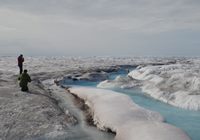£2.4m for research into melting ice sheet

A dark ice surface near the southern margin of the Greenland Ice Sheet
09 June 2015
Scientists at Aberystwyth University are involved in a major new study into factors that are influencing the melting of the Greenland Ice Sheet.
Dr Tristram Irvine-Fynn from the Department of Geography and Earth Sciences at Aberystwyth University will join researchers at the Universities of Bristol, Leeds and Sheffield in a study which has been awarded £2.4 million by the UK Natural Environment Research Council (NERC).
Global warming alone is not enough to account for the increasingly rapid melting of Greenland’s ice sheet. Other factors are darkening the ice sheet surface, which results in greater rates of melting. The collaborative research project will investigate how microbes thrive on melting snow and ice surfaces, and darken the ice sheet surface as a consequence.
Life exists wherever there is liquid water on the Earth’s surface, and ice sheet surfaces are no exception. Just one drop of ice melt contains up to 10,000 microbes. It is only recently that microbiologists have shown that these microorganisms can grow and multiply or ‘bloom’ on melting ice.
Professor Martyn Tranter, the project leader and Principal Investigator for the Bristol team, said: “We aim to understand what controls the growth and blooming of the microorganisms.”
On glacier ice, many of these tiny organisms have green chlorophyll, similar to plants, to capture sunlight and grow, while some develop their own dark-coloured sun-block, to protect themselves from damage by the fierce sunlight that shines for 24 hours a day in the Arctic summer. When these microbes bloom during the summer, they can turn the white and light blue surface of the ice sheet to green-purple or black. This change in colour causes the ice sheet surface to warm and melt much faster.
With expertise in the “biological darkening” of Arctic glaciers, Dr Irvine-Fynn will be involved in monitoring changes in the number of microbes on the ice surface as well as variations of ice colour, structure and topography throughout the summer melt season.
Dr Irvine-Fynn said: “Biological and physical changes at the ice surface affect its reflectivity, or ‘albedo’, which is now recognised as a key determinant of melt rates on Greenland’s ice sheet, under any future climate. Understanding these changes is critical because of their impact on meltwater production, which contributes to predicted sea level rise over the coming decades.”
Over the next five years, the scientists will study these microbes and evaluate how their distribution and growth combine with the other factors to darken the ice surface and enhance the melting of the Greenland Ice Sheet.
The project includes a team of international partner scientists from Denmark, the Netherlands, the US, France, Belgium, Canada, Czech Republic and Japan.
Dr Irvine-Fynn will be working alongside researchers from the University of Sheffield, NASA’s Jet Propulsion Laboratory, KU Leuven Belgium, the Technical University of Denmark and Geological Survey of Denmark (GEUS) to develop computer models that simulate changing ice surface reflectivity.
The work builds on findings from fieldwork already undertaken on the Greenland Ice Sheet by partners at GEUS as part of the Dark Snow Project http://darksnow.org/.
Data from the project will eventually be fed into a computer model simulating melt for the whole ice sheet, and this will help improve forecasts of longer term changes in the volume of the Greenland Ice Sheet and how much sea level rise may occur in the future.
AU17515



